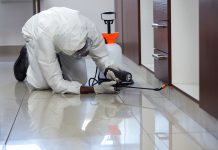No matter how presentable the initial design of the exterior of the building may be, over time, dust and dirt accumulate on the surface of the facade. Resinous and other compounds contained in the air penetrate into the top layer of the coating. Atmospheric precipitation leads to the appearance of stains on masonry and glass surfaces. To restore the attractiveness and presentability of the exterior, it is necessary to regularly (at least 1-2 times a year) wash the facades. It is better to entrust this procedure to specialists WindowWashingExpert.Com, because:
- washing facades usually involves working at height, which only professionals can do;
- in order not to damage the material of the facade, it is necessary to choose the right detergents and cleaning technologies.
First of all, the cleaning method depends on the materials used in its construction and decoration: it can be stone, polymers, glass, metal, etc. Each building material and type of wall has its own washing technology. The cleaning agents used also differ. Today, there are several methods for cleaning the exterior surfaces of a building.
High pressure washer
This is the most widely used technology. In this case, the façade is cleaned by means of a high-pressure water jet. This technique is suitable for washing brickwork, ceramic and glass surfaces, tiles. It is also used to clean signs and windows. Pressurized water applied to the surface acts on adhering dust/dirt particles, helping to separate them. Efficiency depends on the temperature and pressure of the liquid, the slope of the jet, the duration of exposure to the surface. If cleaning with ordinary water is not enough, slightly alkaline cleaning solutions are used for these building materials. The high pressure unit is placed on the roof of the facility or suspended from the wall with the help of special equipment. The liquid is supplied through an elongated hose, which is controlled by a washer (industrial climber).
Hydro jet washing
The technique is based on cleaning the facade with slightly alkaline solutions, which are supplied under slight pressure. The surface is processed 2-5 times. The number of cycles depends on the degree and nature of the facade contamination. This technique is more gentle than the above technology. It is usually used for washing marble, granite and stone walls.
Specific facade cleaning methods
Depending on the material of the facade, other methods can be used, namely:
- sandblasting. It is divided into wet and dry. In the first case, water and abrasive additives are used for washing, in the second case, an air-sand mixture is used;
- cleaning with dry ice. The latter acts as an abrasive substance;
- washing ultra-high (up to 1 thousand bar) pressure. It is used to clean heavy-duty materials that are not afraid of getting wet.
Stages of work
At the first stage, the facade is washed. The outer surface is cleaned of dirt, dust, oil and rain stains, and other contaminants. For masonry walls and tiled cladding, high pressure washing is commonly used. Water or slightly alkaline detergents are used as a cleaning agent. Before starting the main work, the master tests the effect of the selected preparations and methods on a specific material. When positive results are achieved, washing is carried out. Marble and granite surfaces, as well as natural stone walls, are cleaned using slightly alkaline solutions supplied under low pressure. The detergents are then removed with water. The washed facade is treated with specialized protective reagents, the choice of which depends on the materials of construction and decoration. If necessary, the sealing of cracks and other repair and restoration work is additionally performed.
Regular cleaning will not only maintain the attractive appearance of the building, but also prevent premature destruction of the walls due to contamination with dust and chemicals contained in the atmosphere.






